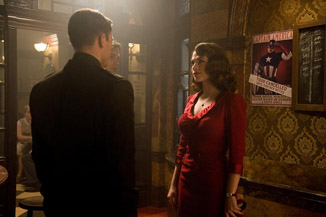(Comic) Book vs. Movie
Captain America
By Russ Bickerstaff
July 28, 2011
Contrary to the image on the cover, Hitler does NOT specifically show-up in the first issue. Captain America doesn’t even leave the U.S. That doesn’t actually happen until the second story in the second issue - a story that involves Cap and Bucky dressing undercover as a grandmother and schoolboy on a plane to Germany. It’s a story that ends with Cap and Bucky personally knocking out Hitler and Goering. That story (“Trapped in the Nazi Stronghold”) was one of the few to feature direct confrontation between the hero and the Nazis prior to 1942. True, there were a few Nazi spies that showed up in a handful of the brief stories that made the pages of the comic book. The Nazi spy thing didn’t exactly dominate the pages, though.
In a typical story of the era, Cap and Bucky square-off against “The Wax Man” - a spy with a German accent who looks to take over the world with futuristic tanks in the interest of establishing a “new order.” There’s no specific mention of the Nazis or Germany for that matter… Of course, once open hostilities exploded between the two nations at the end of 1941, things changed.
Through it all, Captain America is an indestructible hero. He gets captured, but never actually hurt. Out of costume as a perpetual private, he gets casually reprimanded as a lowly private. He smokes a pipe. Aside from a general swashbuckling bravado, we never get a deeper image of who the characters of Steve, Cap or Bucky really are. The stories all follow a very regimented formula involving a monstrous villain from (or funded from) overseas who is trying to destroy US morale by some sinister plan that ends up getting foiled after a tussle with Cap and Bucky.
Occasionally, tiny bits of personality do filter through the story. Most notably, there was kind of a chilling scene at the end of the first Red Skull story in which the Skull accidentally rolls over a hypodermic of poison in a tussle with Bucky as Cap looks on. After the Red Skull dies, Bucky asks Captain America, “…you saw it all - why didn’t you stop him from killing himself?” To which Cap replies, “I’m not talking, Bucky!” And it's never brought-up again. The US could have presumably learned a lot from a US-based Nazi super-spy and Captain America let him die - presumably out of spite. It’s an uncharacteristically dark moment in an otherwise cheerily grandiose action/espionage series. (Red Skull, of course, returns a couple of issues later having survived the poison.)
The Movie
Whereas the original comic book was created and produced by people with a great deal of interest in US foreign policy, the producers of the current film version aren’t all that interested in current events. The idea here is to make money to expand business for Marvel Productions’ growing line of superhero films. A single piece in a highly ambitious, highly interconnected series of big-budget action films, Captain America: The First Avenger is more interested in telling a good story than influencing public opinion.
Continued:
1
2
3
4
5
6




